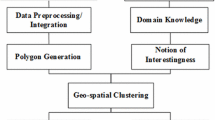Abstract
Change detection on spatial data is important in many applications, such as environmental monitoring. Given a set of snapshots of spatial objects at various temporal instants, a user may want to derive the changing regions between any two snapshots. Most of the existing methods have to use at least one of the original data sets to detect changing regions. However, in some important applications, due to data access constraints such as privacy concerns and limited data online availability, original data may not be available for change analysis. In this paper, we tackle the problem by proposing a simple yet effective model-based approach. In the model construction phase, data snapshots are summarized using the novel cluster-embedded decision trees as concise models. Once the models are built, the original data snapshots will not be accessed anymore. In the change detection phase, to mine changing regions between any two instants, we compare the two corresponding cluster-embedded decision trees. Our systematic experimental results on both real and synthetic data sets show that our approach can detect changes accurately and effectively.
Similar content being viewed by others
References
Agrawal, R., Imielinski, T., & Swami, A. (1993). Mining association rules between sets of items in large databases. In proceedings of the ACM-SIGMOD international conference on management of data (SIGMOD’93) (pp. 207–216). Washington, DC, May.
Agrawal, R., & Psaila, G. (1995). Active data mining. In Proceedings of the 1st international conference on knowledge discovery in databases and data mining.
Billard, L., & Diday E. (2003). From the statistics of data to the statistic of knowledge: Symbolic data analysis. JASA. Journal of the American Statistical Association, 98, Nb. 462, June.
Cover, T. M., & Thomas, J. A. (1991). Elements of information theory. New York: Wiley.
Diday, E., & Esposito, F. (2003). An introduction to symbolic data analysis and the sodas software. IDA. International Journal on Intelligent Data Analysis, 7(6).
Eiter T., & Mannila, H. (1997). Distance measures for point sets and their computation. Acta Informatica, 34(2), 103–133.
Ganti, V., Gehrke, J., & Ramakrishnan, R. (1999). A framework for measuring changes in data characteristics. In proceedings of the Eighteenth ACM SIGAST–SIGMOD–SIGART Symposium on Principles of Database Systems, May 31–June 2, 1999, Philadelphia, Pennsylvania (pp. 126–137). ACM.
Liu, B., Hsu, W., Han, H., & Xia, Y. (2000). Mining changes for real-life applications. In DaWaK 2000: Proceedings of the Second International Conference on Data Warehousing and Knowledge Discovery (pp. 337–346). London, UK: Springer.
Liu, B., Hsu, W., & Ma, Y. (2001). Discovering the set of fundamental rule changes. In Proceedings of the seventh ACM SIKDD international conference on Knowledge discovery and data mining (KDD’01) (pp. 335–340). San Francisco, California, USA: ACM.
Oliver, M. A., & Webster, R. (1990). Kriging: A method of interpolation for geographical information systems. International Journal of Geographic Information Systems, 4(3).
Papoulis, A. (1984). Probability, random variables, and stochastic processes (2nd ed.) (pp. 149–151). New York: McGraw-Hill.
Quinlan, J. R. (1993). C4.5: Programs for machine learning. San Mateo, CA: Morgan Kaufmann.
Rote, G. (1991). Computing the minimum Hausdorff distance between two point sets on a line under translation. Information Processing Letters, 38, 123–127.
Ruggles, S., Sobek, M., Alexander, T., Fitch, C. A., Goeken, R., Hall, P. K., et al. (2004). Integrated public use microdata series: Version 3.0 [http://www.ipums.org]. Minneapolis, MN: Minnesota Population Center.
Wang, K., Zhou, S., Fu, C. A., & Yu, X. J. (2003). Mining changes of classification by correspondence tracing. In Proceedings of the 2003 SIAM International Conference on Data Mining (SDM’2003). San Francisco, CA, USA, May.
Witten, I. H., & Frank, E. (2005) Data mining: Practical machine learning tools and techniques (2nd ed.). San Francisco: Morgan Kaufmann.
Author information
Authors and Affiliations
Corresponding author
Additional information
Irene Pekerskaya’s and Jian Pei’s research is supported partly by National Sciences and Engineering Research Council of Canada and National Science Foundation of the US, and a President’s Research Grant and an Endowed Research Fellowship Award at Simon Fraser University. Ke Wang’s research is supported partly by Natural Sciences and Engineering Research Council of Canada. All opinions, findings, conclusions and recommendations in this paper are those of the authors and do not necessarily reflect the views of the funding agencies.
Rights and permissions
About this article
Cite this article
Pekerskaya, I., Pei, J. & Wang, K. Mining changing regions from access-constrained snapshots: a cluster-embedded decision tree approach. J Intell Inf Syst 27, 215–242 (2006). https://doi.org/10.1007/s10844-006-9951-9
Published:
Issue Date:
DOI: https://doi.org/10.1007/s10844-006-9951-9




